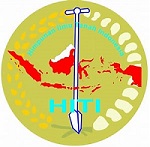KANDUNGAN LOGAM BERAT TIMBAL, TEMBAGA, DAN ARSEN PADA SEDIMEN DI BENDUNGAN LOMAYA DAN BENDUNGAN ALOPOHU
DOI:
https://doi.org/10.35791/se.22.1.2022.39884Keywords:
Heavy Metal, Lead (Pb), Copper (Cu), Arsenic (As), Dam SedimentsAbstract
HEAVY METAL CONTENTS OF Pb, Cu, AND As IN SEDIMENTS OF LOMAYA AND ALOPOHU DAMS
This research determined heavy metal level of lead (Pb), Copper (Cu), and Arsenic (As) content in the sediment at Lomaya and Alopohu dams. Lomaya Dam located at Bolango Ulu Sub-district, District of Bone Bolango and Alopohu Dam at Dungalio Sub-district, district of Gorontalo. Sediment samples of Lomaya was taken at point of N 00037’70,6†E 123004’96â€, while that of Alopohu dam was taken at the coordinate of N 00033’29.5†E 122053’38.6â€. This research was conducted from April to May 2016. It reveals that the samples from both dams were contaminated with heavy metals of Pb, Cu, and As. The levels of heavy metals in Lomaya were 4,226 mg Pb/kg sediment, 1.225 mg Cu/kg sediment, and 0.148 mg As/kg sediment. Heavy metals in Alopohu dam were 4.198 mg Pb/kg, 4.225 mg Cu /kg, and 0.227 mg As/kg). The level of these three heavy metals both in Lomaya and Alopohu dams were below the allowed limit (Pb >30 mg/kg, Cu >65 mg/kg dan As >75 mg/kg). The statistical test of t test showed that the Pb level was not significantly differ from Cu level, but it was significantly different from the As level. In addition the Cu level did not significantly differ from the As level in both dams.
Downloads
Published
How to Cite
Issue
Section
License
Copyright (c) 2022 Mohamad Zikra Asiari, Nurmi Nurmi, Fitriah S. Jamin, Muhammad A. Azis

This work is licensed under a Creative Commons Attribution-NonCommercial 4.0 International License.
Authors who publish in this journal agree to the following terms:
Authors hold their copyright and grant this journal the privilege of first publication, with the work simultaneously licensed under a Creative Commons Attribution License that permits others to impart the work with an acknowledgment of the work's origin and initial publication by this journal.
Authors can enter into separate or additional contractual arrangements for the non-exclusive distribution of the journal's published version of the work (for example, post it to an institutional repository or publish it in a book), with an acknowledgment of its underlying publication in this journal.
Authors are permitted and encouraged to post their work online (for example, in institutional repositories or on their website) as it can lead to productive exchanges, as well as earlier and greater citation of the published work (See The Effect of Open Access).




